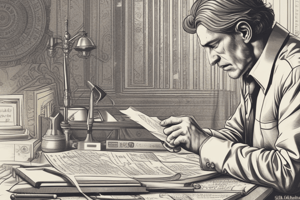Podcast
Questions and Answers
Which event directly preceded the Mexican-American War?
Which event directly preceded the Mexican-American War?
- The formation of the National Conference of Charities and Corrections
- The U.S. Civil War
- The perfection of internal combustion engines
- The annexation of portions of Mexico as Texas (correct)
The Elmira Reformatory in New York is most notable for which of the following milestones?
The Elmira Reformatory in New York is most notable for which of the following milestones?
- Forming the American Association of Social Workers
- Developing early police social work programs
- Establishing the first juvenile court in the U.S.
- Releasing the first parolee in history (correct)
What was a significant outcome of the 1929 U.S. stock market crash?
What was a significant outcome of the 1929 U.S. stock market crash?
- The establishment of the first social work training school
- The appointment of Eleanor Roosevelt to a presidential commission
- The onset of the Great Depression (correct)
- The rise of police social workers
What was the primary focus of U.S. policy regarding women in the 1950s?
What was the primary focus of U.S. policy regarding women in the 1950s?
Which entity documented discrimination in the workplace in 1963?
Which entity documented discrimination in the workplace in 1963?
What best describes the shift in Federal social policies during the 1960s?
What best describes the shift in Federal social policies during the 1960s?
The opening of the first shelter for female victims of battering occurred in what U.S. state?
The opening of the first shelter for female victims of battering occurred in what U.S. state?
What is a key characteristic of forensic social workers?
What is a key characteristic of forensic social workers?
What is a key significance of the English Poor Laws of 1601 in the context of forensic social work history?
What is a key significance of the English Poor Laws of 1601 in the context of forensic social work history?
According to the options, how were individuals in poverty categorized under the English Poor Laws of 1601?
According to the options, how were individuals in poverty categorized under the English Poor Laws of 1601?
What was a primary reason early English colonists were hesitant to rely on government for maintaining law and order?
What was a primary reason early English colonists were hesitant to rely on government for maintaining law and order?
What was the typical consequence for criminals who were caught by colonists during this time?
What was the typical consequence for criminals who were caught by colonists during this time?
How did early English colonists handle the impoverished within their settlements?
How did early English colonists handle the impoverished within their settlements?
What does the description of early police forces in colonial settlements, composed of men patrolling streets, suggest about their approach to law enforcement?
What does the description of early police forces in colonial settlements, composed of men patrolling streets, suggest about their approach to law enforcement?
According to the information, what was an attitude towards victims of crime during the colonial era?
According to the information, what was an attitude towards victims of crime during the colonial era?
What does the content suggest about the historical progression from the English Poor Laws to forensic social work?
What does the content suggest about the historical progression from the English Poor Laws to forensic social work?
Which institution was established as a direct result of advocacy by residents of Hull House?
Which institution was established as a direct result of advocacy by residents of Hull House?
By what year had the majority of U.S. states established juvenile courts?
By what year had the majority of U.S. states established juvenile courts?
Prior to juvenile justice reforms, what was the main focus of the Society for Prevention of Cruelty to Children based upon?
Prior to juvenile justice reforms, what was the main focus of the Society for Prevention of Cruelty to Children based upon?
Mary Richmond advocated for which approach in social work?
Mary Richmond advocated for which approach in social work?
What was Jane Addams' viewpoint on how children should be perceived in policy?
What was Jane Addams' viewpoint on how children should be perceived in policy?
What was one of the key changes afforded to children within the juvenile justice system?
What was one of the key changes afforded to children within the juvenile justice system?
Which concept saw a renewed commitment during the time juvenile courts were being formed?
Which concept saw a renewed commitment during the time juvenile courts were being formed?
What was the purpose behind renaming prisons to 'penitentiaries'?
What was the purpose behind renaming prisons to 'penitentiaries'?
What was the primary conclusion of Robert Martinson's initial publication, 'What Works?' regarding rehabilitation programs?
What was the primary conclusion of Robert Martinson's initial publication, 'What Works?' regarding rehabilitation programs?
How did the full publication of the 'What Works?' study, co-authored by Lipton and Wilks, differ from Martinson's initial conclusions?
How did the full publication of the 'What Works?' study, co-authored by Lipton and Wilks, differ from Martinson's initial conclusions?
Following Martinson's initial publication, what was a major shift in the focus of collaborative forensic social work?
Following Martinson's initial publication, what was a major shift in the focus of collaborative forensic social work?
Within community-based victim/witness assistance programs, approximately what percentage of staff are social workers?
Within community-based victim/witness assistance programs, approximately what percentage of staff are social workers?
What was the purpose of the federal RESTTA initiative, funded in the mid-1980s?
What was the purpose of the federal RESTTA initiative, funded in the mid-1980s?
Which of the following was NOT a method of accountability promoted by the RESTTA initiative?
Which of the following was NOT a method of accountability promoted by the RESTTA initiative?
What is a primary characteristic of "tough love" projects like boot camps, aimed at high-risk young offenders?
What is a primary characteristic of "tough love" projects like boot camps, aimed at high-risk young offenders?
What major event significantly changed forensic policy and social worker roles, as mentioned in the text?
What major event significantly changed forensic policy and social worker roles, as mentioned in the text?
The concept of early release from prison as a reward for good behavior was introduced in response to which concern?
The concept of early release from prison as a reward for good behavior was introduced in response to which concern?
What was John Augustus' primary contribution to social reform in the early 1840's?
What was John Augustus' primary contribution to social reform in the early 1840's?
The Juvenile Justice and Delinquency Prevention Act was passed in which year?
The Juvenile Justice and Delinquency Prevention Act was passed in which year?
Before becoming known as correctional institutions, prisons were often indistinguishable from which type of facilities?
Before becoming known as correctional institutions, prisons were often indistinguishable from which type of facilities?
What event is associated with a shift in US society towards a 'get tough on crime' approach?
What event is associated with a shift in US society towards a 'get tough on crime' approach?
What is a defining characteristic of the 19th-century approach to legal and correctional policies?
What is a defining characteristic of the 19th-century approach to legal and correctional policies?
Which act resulted in the creation of new executive branch powers related to certain crimes?
Which act resulted in the creation of new executive branch powers related to certain crimes?
What was the primary focus of social work after the establishment of the American Association of Social Workers in 1921?
What was the primary focus of social work after the establishment of the American Association of Social Workers in 1921?
By 1920, approximately what fraction of states had implemented some form of probation?
By 1920, approximately what fraction of states had implemented some form of probation?
What significant event caused a shift in social work's focus towards social change and policy revisions?
What significant event caused a shift in social work's focus towards social change and policy revisions?
Which of the following best describes an influence that social workers had on New Deal programs?
Which of the following best describes an influence that social workers had on New Deal programs?
What role did Frances Perkins play in social reform as a former social worker?
What role did Frances Perkins play in social reform as a former social worker?
What was a key feature of the Works Projects Administration overseen by Harry Hopkins?
What was a key feature of the Works Projects Administration overseen by Harry Hopkins?
When were police social workers common, and what was a key function of these roles?
When were police social workers common, and what was a key function of these roles?
Why did police social worker positions decline after the Great Depression, and when did they return to prominence?
Why did police social worker positions decline after the Great Depression, and when did they return to prominence?
What led to many child guidance clinics opening in the 1940s that employed social workers?
What led to many child guidance clinics opening in the 1940s that employed social workers?
Flashcards
The Great Depression
The Great Depression
A period of significant economic downturn in the United States, triggered by the stock market crash of 1929. This event had a profound impact on social work as it increased poverty and the need for social services.
Social Movement (1960s/1970s)
Social Movement (1960s/1970s)
The movement for the advancement of women's rights in the US, gaining momentum in the 1960s and 1970s. This period saw significant legal and social changes for women, impacting social work by highlighting gender inequality and advocating for women's rights.
Parole
Parole
A legal process that allows convicted individuals to be released from prison before the completion of their sentence, under the supervision of a parole officer. The concept originated in the late 1800s and became a significant part of the criminal justice system.
Probation
Probation
Signup and view all the flashcards
First Juvenile Court
First Juvenile Court
Signup and view all the flashcards
National Conference of Charities and Corrections
National Conference of Charities and Corrections
Signup and view all the flashcards
Forensic Social Workers
Forensic Social Workers
Signup and view all the flashcards
Police Social Workers
Police Social Workers
Signup and view all the flashcards
English Poor Laws of 1601
English Poor Laws of 1601
Signup and view all the flashcards
Role of Advocates in the English Poor Laws
Role of Advocates in the English Poor Laws
Signup and view all the flashcards
Colonial Adoption of English Poor Laws
Colonial Adoption of English Poor Laws
Signup and view all the flashcards
Colonial Reluctance to Centralized Law Enforcement
Colonial Reluctance to Centralized Law Enforcement
Signup and view all the flashcards
Colonial Punishment Practices
Colonial Punishment Practices
Signup and view all the flashcards
Early Colonial Views on Crime and Rehabilitation
Early Colonial Views on Crime and Rehabilitation
Signup and view all the flashcards
Roots of Forensic Social Work
Roots of Forensic Social Work
Signup and view all the flashcards
What is Forensic Social Work?
What is Forensic Social Work?
Signup and view all the flashcards
Juvenile Court System
Juvenile Court System
Signup and view all the flashcards
Rehabilitation
Rehabilitation
Signup and view all the flashcards
Juvenile Courts
Juvenile Courts
Signup and view all the flashcards
Psychosocial Assessments
Psychosocial Assessments
Signup and view all the flashcards
Society for Prevention of Cruelty to Children (NYSPCC)
Society for Prevention of Cruelty to Children (NYSPCC)
Signup and view all the flashcards
Reform of the Individual
Reform of the Individual
Signup and view all the flashcards
Repentance
Repentance
Signup and view all the flashcards
Early Release
Early Release
Signup and view all the flashcards
Get Tough on Crime
Get Tough on Crime
Signup and view all the flashcards
Victims of Crime Act
Victims of Crime Act
Signup and view all the flashcards
Patriot Act
Patriot Act
Signup and view all the flashcards
Informal Incarceration
Informal Incarceration
Signup and view all the flashcards
The 19th Century Correctional Reforms
The 19th Century Correctional Reforms
Signup and view all the flashcards
Social Change Emphasis
Social Change Emphasis
Signup and view all the flashcards
American Association of Social Workers
American Association of Social Workers
Signup and view all the flashcards
Correctional Treatment Specialists
Correctional Treatment Specialists
Signup and view all the flashcards
Social Workers and the 'New Poor'
Social Workers and the 'New Poor'
Signup and view all the flashcards
Youth Gangs and Child Guidance Clinics
Youth Gangs and Child Guidance Clinics
Signup and view all the flashcards
Frances Perkins and Social Reform
Frances Perkins and Social Reform
Signup and view all the flashcards
Works Projects Administration (WPA)
Works Projects Administration (WPA)
Signup and view all the flashcards
Martinson's "What Works?"
Martinson's "What Works?"
Signup and view all the flashcards
Shift from prison-based rehabilitation to community-based programs
Shift from prison-based rehabilitation to community-based programs
Signup and view all the flashcards
Community corrections initiatives
Community corrections initiatives
Signup and view all the flashcards
RESTTA (Restitution Education, Specialized Training, and Technical Assistance)
RESTTA (Restitution Education, Specialized Training, and Technical Assistance)
Signup and view all the flashcards
Youth-focused 'boot camp' or 'tough love' programs
Youth-focused 'boot camp' or 'tough love' programs
Signup and view all the flashcards
Social work post 9/11
Social work post 9/11
Signup and view all the flashcards
New chapter in forensic policy
New chapter in forensic policy
Signup and view all the flashcards
Evolution of Forensic Social Work
Evolution of Forensic Social Work
Signup and view all the flashcards
Study Notes
History of Forensic Social Work in the United States
- Social workers respond to individuals within the criminal justice system, working to change both the system and laws.
- Forensic social work is as old as social work itself, encompassing diverse roles such as advocating for accused individuals, supporting victims, working with juvenile justice systems, and testifying in court.
- It involves improving or changing U.S. justice systems' processes and policies.
- Social work centers around social justice and human rights, offering support to those vulnerable groups and advocating for empowerment in families and communities.
The Colonial Era
- English Poor Laws (1601) represented a merging of law and social policy, creating government-led responses to those in poverty.
- These laws categorized individuals as deserving, undeserving, or children.
- English colonists were influenced by these laws, creating responses involving almshouses and workhouses to manage poverty.
- Early colonial responses to crime focused on swift, corporal punishment, lacking rehabilitation or victim support.
- Jails served as holding centers, lacking rehabilitation emphasis.
The 1800s
- The 19th century saw increased questioning of criminal justice philosophies and questioned their effectiveness.
- The concept of early release, based on good behavior, was created—parole.
- John Augustus, a wealthy Bostonian, pioneered social reform and influenced probation practices.
- Probation practice spread through the United States, extending the concept of rehabilitation through discipline and programs within prisons, offering early release or preventing future incarceration.
- These early practices foreshadowed those used in modern forensic social work, considering human capacity for change.
The 20th Century and the Birth of Social Work
- The National Conference of Charities and Corrections (later the National Association of Social Workers) was formed in 1879 to address social issues.
- Social work developed as a profession, with increasing focus on social reform, particularly regarding children and law/justice issues.
- Key figures like Mary Richmond and Jane Addams championed social reform and influenced policy affecting the poor.
- Early juvenile courts were developed, distinguishing children's cases from those of adults and addressing the needs of abused and neglected youth.
- Juvenile justice reforms aimed at avoiding harsh juvenile prison terms as well as recognizing youth’s special needs.
Collaborative Reforms in Adult Courts
- The advent of parole and juvenile courts in the late 1800s and early 1900s contributed to renewed commitment to individual rehabilitation.
- The criminal justice system increasingly adopted a focus on reform in response to social needs and concerns.
- Forensic social workers developed expertise in systems and became involved in correctional treatment programs, pretrial, diversion programs and youth service bureaus.
Government Policy and Social Work
- Social workers testified in front of congressional committees to advocate for reform in policy and create regulations on worker safety.
- The New Deal programs were heavily influenced by social work expertise, especially under Frances Perkins (involving safe work conditions and social security).
- Programs for youth and delinquency-prevention emerged, expanding the role of forensic social workers in government agencies.
Social Work Post 9-11
- The 2001 terrorist attacks in the U.S. greatly impacted local, state, and federal legal/justice systems and policy.
- New laws, including the Patriot Act, influenced how government interacted with accused individuals and influenced the role of forensic social work.
Studying That Suits You
Use AI to generate personalized quizzes and flashcards to suit your learning preferences.




